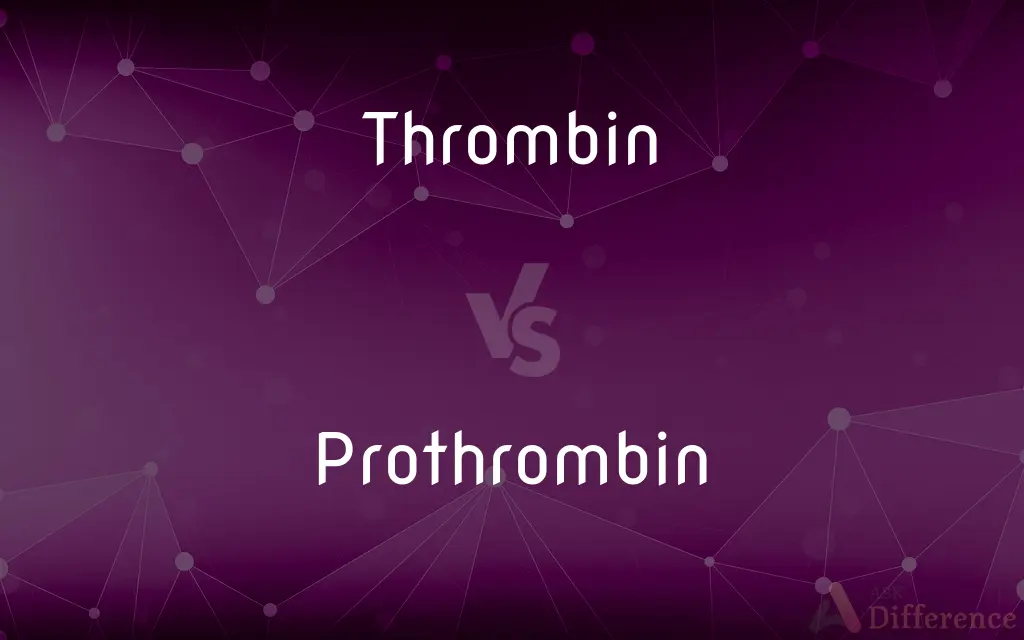Thrombin vs. Prothrombin — What's the Difference?
By Tayyaba Rehman — Updated on September 27, 2023
Thrombin is an active enzyme that converts fibrinogen into fibrin clots. Prothrombin is its inactive precursor, which is transformed into thrombin during blood clotting. Both are vital in hemostasis.

Difference Between Thrombin and Prothrombin
Table of Contents
ADVERTISEMENT
Key Differences
Thrombin and Prothrombin are both integral to the blood coagulation cascade. Thrombin is an enzyme that plays a pivotal role in the conversion of fibrinogen to fibrin, forming blood clots. On the other hand, Prothrombin, often designated as factor II, is the precursor to thrombin.
The transformation of Prothrombin into Thrombin is a critical step in the clotting process. This conversion is catalyzed by the enzyme prothrombinase. Once Prothrombin is activated to become Thrombin, it can then act on fibrinogen to facilitate clot formation.
It's vital to understand that while Thrombin has an active role in clotting, Prothrombin is inactive in its native state. Only when it's transformed into Thrombin does it actively partake in the coagulation mechanism, emphasizing the sequential nature of the clotting cascade.
Both Thrombin and Prothrombin have been targets for medical research, especially in the context of anticoagulant therapies. In conditions where clotting is excessive or unwanted, understanding the roles and regulation of both can be pivotal for treatment strategies.
In essence, the relationship between Thrombin and Prothrombin is one of a precursor and its product. Both molecules, though at different stages, are indispensable for the intricate process of hemostasis.
ADVERTISEMENT
Comparison Chart
Definition
Active enzyme in clotting.
Inactive precursor in clotting.
Role in Coagulation
Converts fibrinogen to fibrin.
Transformed into thrombin.
Activation
By prothrombinase.
Requires activation.
State
Active.
Inactive (until converted).
Clinical Relevance
Target for anticoagulants.
Studied in clotting disorders.
Compare with Definitions
Thrombin
Product of prothrombin activation.
Once prothrombin is activated, it becomes thrombin.
Prothrombin
Inactive precursor to thrombin.
Prothrombin transforms into thrombin during clotting.
Thrombin
Enzyme converting fibrinogen to fibrin.
Thrombin is pivotal in the final stages of the clotting cascade.
Prothrombin
Known as clotting factor II.
Factor II, or prothrombin, is essential for hemostasis.
Thrombin
Active component in hemostasis.
Thrombin ensures that wounds stop bleeding by forming clots.
Prothrombin
Requires activation for clotting role.
Prothrombin must be activated to partake in coagulation.
Thrombin
Target for many anticoagulant therapies.
Certain drugs inhibit thrombin to prevent excessive clotting.
Prothrombin
Protein produced by the liver.
The liver synthesizes prothrombin, which circulates in the bloodstream.
Thrombin
Catalyst in blood coagulation.
Without thrombin, fibrin clots wouldn't form.
Prothrombin
Central to the coagulation cascade.
Any disruption in prothrombin levels can affect clotting.
Thrombin
Thrombin (EC 3.4.21.5, fibrinogenase, thrombase, thrombofort, topical, thrombin-C, tropostasin, activated blood-coagulation factor II, blood-coagulation factor IIa, factor IIa, E thrombin, beta-thrombin, gamma-thrombin) is a serine protease, an enzyme that, in humans, is encoded by the F2 gene. Prothrombin (coagulation factor II) is proteolytically cleaved to form thrombin in the clotting process.
Prothrombin
A plasma protein that is converted into thrombin during blood clotting.
Thrombin
A protease in blood that facilitates blood clotting by converting fibrinogen to fibrin.
Prothrombin
(protein) A glycoprotein, produced in the liver, that is converted into thrombin during bleeding and subsequent clotting.
Thrombin
(enzyme) An enzyme in blood that facilitates blood clotting by converting fibrinogen to fibrin (by means of ionized calcium).
Prothrombin
A protein in blood plasma that is the inactive precursor of thrombin
Thrombin
The enzyme which converts fibrinogen into fibrin.
Thrombin
An enzyme that acts on fibrinogen in blood causing it to clot
Common Curiosities
Why is prothrombin crucial for clotting?
Prothrombin, when activated, becomes thrombin, which is essential for converting fibrinogen to fibrin.
Can imbalances in thrombin cause medical conditions?
Yes, excessive or reduced thrombin activity can lead to bleeding or clotting disorders.
What is thrombin's primary function?
Thrombin converts fibrinogen to fibrin, leading to clot formation.
How is prothrombin activated?
Prothrombin is activated to thrombin by the enzyme prothrombinase.
Is thrombin always active in the bloodstream?
No, thrombin is formed from its inactive precursor, prothrombin, during the clotting process.
Are there medications that target thrombin?
Yes, some anticoagulant drugs inhibit thrombin to prevent or treat clotting.
Can thrombin act on other proteins besides fibrinogen?
While its primary role is to act on fibrinogen, thrombin can influence other proteins and processes in the clotting cascade.
Is prothrombin present in all vertebrates?
Yes, prothrombin, or its analogs, play a role in the coagulation systems of most vertebrates.
How is prothrombin measured in the lab?
Prothrombin time (PT) is a test that measures how long it takes blood to clot and indirectly measures prothrombin levels.
Where is prothrombin produced in the body?
Prothrombin is synthesized by the liver.
What can cause elevated thrombin levels?
Conditions like deep vein thrombosis or certain genetic factors can lead to increased thrombin production.
Share Your Discovery

Previous Comparison
Purple vs. Pink
Next Comparison
Water vs. IceAuthor Spotlight
Written by
Tayyaba RehmanTayyaba Rehman is a distinguished writer, currently serving as a primary contributor to askdifference.com. As a researcher in semantics and etymology, Tayyaba's passion for the complexity of languages and their distinctions has found a perfect home on the platform. Tayyaba delves into the intricacies of language, distinguishing between commonly confused words and phrases, thereby providing clarity for readers worldwide.
















































